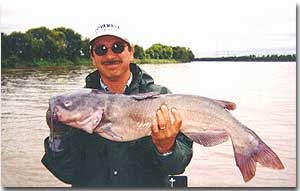Anatomy of a Cattin' River Part#1
Anatomy of a Cattin' River Part#1
By Dan Kiazyk
Part 1 – Getting to know a new “Cat” water.
Just as your doctor has training knowing the constituent parts of the human body, the river rat knows most of the nooks and crannies of the river he fishes. Just as every human body has common parts so too does the catfish river have its locales where catfish will be present. Knowing these general locations can make any visitors trip to a new cattin’ water that much more productive.
 So where do you start? My initiation to the anatomy of the cattin river came from a domaine far away from cat fishing: fly fishing. Fly fisherman for years have dissected rivers to get to know where their favorite quarry will live and eat. In most of the literature related to fly fishing there are three places that have been identified as being places where you might catch trout: Riffles, Run and Pool.. These three areas, I will suggest are also significant for the catman (surprise!)
So where do you start? My initiation to the anatomy of the cattin river came from a domaine far away from cat fishing: fly fishing. Fly fisherman for years have dissected rivers to get to know where their favorite quarry will live and eat. In most of the literature related to fly fishing there are three places that have been identified as being places where you might catch trout: Riffles, Run and Pool.. These three areas, I will suggest are also significant for the catman (surprise!)
Riffles: These areas will hold active cats in almost any season. The rolling action of the water oxygenates the water and draws many of the catfish’s favorite foods. You can even anchor in these areas and at times run into a mess of active cats. Earlier on in the season these areas (when the water is still cooler) will hold cats for longer periods of the day and as the season progresses these area will produce for shorter periods where the cats are on the chew. Cats on occasion will also use small obstructions in these faster water areas to rest. If you can see these obstructions, and are able to put your rig behind them, you will be pleasantly surprised by the regularity of the bites.
Runs: In the catfish world, runs are those river channels that are like highways by which fish travel from point to point. On some occasions during some times of the year, cats will be in the channels for extended periods of time. I’ll often check these highways by criss-crossing over them all the while paying attention to any marks on the sonar. It’s surprising how you’ll often see fish concentrated along these highways. In these instances, I’ll anchor just off to the side and cast out into the channel or into the ledge area of the channel.
Pools: Finally this last component of the river is by far not the least when it gets down to catching a bunch of cats. Pools or holes are where cats will spend a great deal of their time. knowing where in the hole and which holes (dependant on the season) will have an enormous impact on your cattin’ success. I would say that throughout the soft water period there will always be cats biting in this or that hole….the challenge will be to find those holes which are the most productive on any given day.
Just focusing on these three prior areas will, however, limit your cattin’ options. Other possibilities include; large flats and rock piles (present holes, channels and flats).
Flats are significant during particular seasons and at different times of the day. When goldeye frequent these large non-descript areas cats aren’t far behind. This latter explanation explains for a large part the presence of cats in these areas. Generally the presence of this favorite summertime forage of the Red River channel cat will occur in late spring and early summer. When temperatures start to rise and goldeye move to other parts of the water column, cats seem to evacuate these areas. Time of day, can also impact on whether cats will be present or not. Barren flats during the day can become hot beds of action at night. This becomes the case on deeper flats in mid summer. All it takes to know whether they’re there or not is to move in and sit a spell (but don’t stay too long!).
Rock piles finally are a component of any river that should not be overlooked when cattin. Rock piles have a tendency to attract baitfish and in turn, they attract cats – especially hungry cats. Rock piles also have the capacity to create current breaks which will give cats a bit of respite in what can be a furious environment. The problem when fishing around these rock piles is they tend to eat tackle. Shortening up leads and lightening up weights can help in this context. I’ve tried the break-away weight idea but how many weights can you spare!
Certainly structural components exist with any given river and getting to know them will impact upon your cattin’ success. These qualities are not completely static – they may even change to a degree from year to year. Nonetheless, there area components that are recognizable from river to river. Knowing these components will only improve your chances of hooking up with ol’ whiskers.
|
